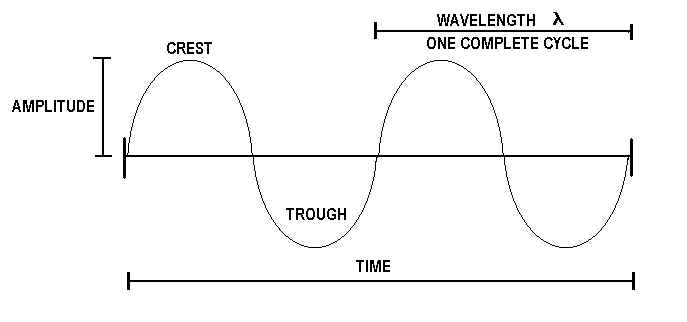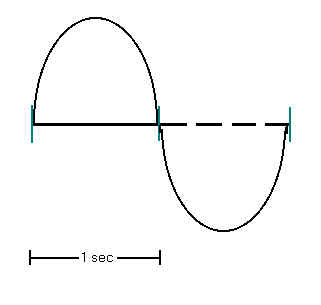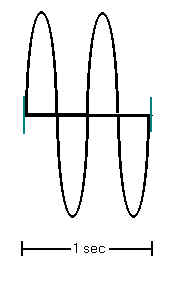| FREQUENCY
AND MODULATION Electromagnetic energy travels in wave form; and all waves can be expressed in as frequencies. Frequency is the number of wave cycles per unit of time:
Look at the diagram above: the height of the wave is the amplitude. The wavelength is the physical distance covered as the wave completes one cycle - from start to end. Radio waves can be expressed either by frequency or wavelength. The unit of frequency measure is Hertz, and that represents "cycles per second". Now look at these frequency representations.
Figure A represents a lower frequency. Only half of the wave is completed in one second. In figure B, two complete waves are completed in one second, a higher frequency has been generated. You can relate frequency to pitch, as the frequency goes up than the pitch goes up as well. There is an inverse relationship between frequency and wavelength. As the frequency increases, the wavelength decreases. Look at figure B again - there is more wave scrunched up into the allotted time, enough for the wave to cycle twice. And of course, as frequency decreases, the wavelength increases.
Radiofrequency energy is broadcast across many different frequencies. The frequencies are divided up into different groups called bands. The lowest frequencies of energy are not considered radiofrequency because they can be detected by the human ear; these are called audio frequencies. The range of this energy is from about 20 hertz (Hz) to 20,000 Hz. All frequencies above this cut-off limit are considered radiofrequencies - which constitutes a huge portion of non-visible radiation. Refer to the list below to see where they fall on the amateur frequency spectrum:
MODULATION Radiofrequencies are simply the mediums in which we can use to convey messages to other, but in order for them to be useful, we have to modify them to carry the message. The process of combining an information signal with a radio signal is referred to as modulation. Pure signals that have not been modified to carry information are called carrier frequencies. The carrier is of constant amplitude. To modulate the carrier, a modulating signal which consist of the electronic message is superimposed over it. Thus, the carrier and the modulated message become the modulated signal. There are different methods of forming the information portion of the message to electronically mimic a speech signal. With amplitude modulation (AM), the amplitude (height of the wave) is manipulated. When this happens, the message ends up "spreading" itself over a range of frequencies - this happens with all modulated frequencies. Because the frequency is carrying intelligence, it takes up more room. The frequencies affected above the carrier are called upper sidebands, while those below are called lower sidebands. The range of frequencies now affected by that signal are the bandwidth. And as more intelligence is added to the carrier, then the bandwidth increases in size. AM waste some energy because the message is sent twice, so to speak. The upper sideband alone conveys the interpretable message, but so does the lower side band. So a redundancy occurs, and half of the energy is wasted. Eventually, the single sideband concept (SSB) was developed. A filter is used to cut out one side of an AM signal, leaving the other side to be amplified and transmitted. This opens up the unused sideband frequencies to be utilized so that now two signals can occupy the space that it took for one signal! Hams take full advantage of SSB, but even though the process has been well proven for over 50 years, AM broadcast facilities still do not utilize it. With frequency modulation (FM), the frequency of a wave is manipulated to add information. When looking at an FM wave on an oscilliscope, the amplitude remains at one height, but the length is manipulated throughout to add the message - it ends up streched out in some places and compacted in others. FM transmissions have the advantage of high fidelity and little interference from static electrical noise, but take up a lot more bandwidth than AM signals, typically about 10 kHz. Another type of modulation is called phase modulation (PM) in which a reactance modulator is used to shift the phase of the carrier. FM modulation is frequently used on VHF and UHF bands. PM sounds very much like FM, and the signals are often indistinguishable.
|



